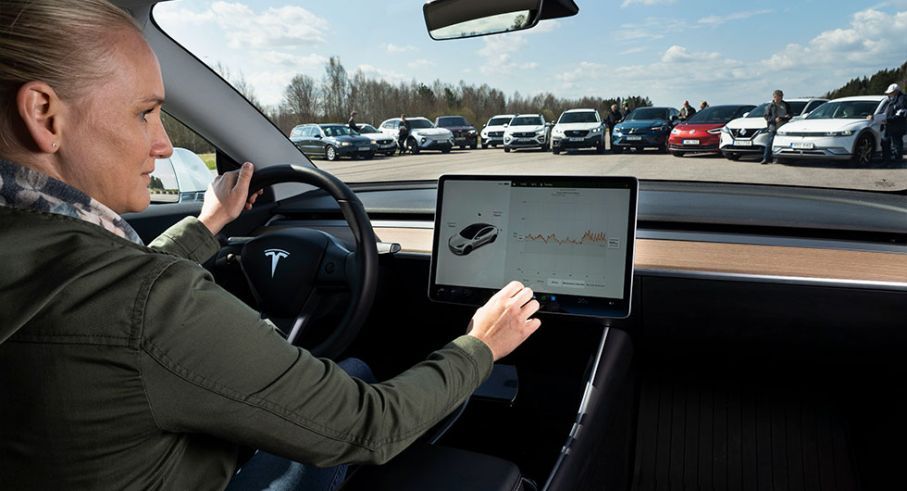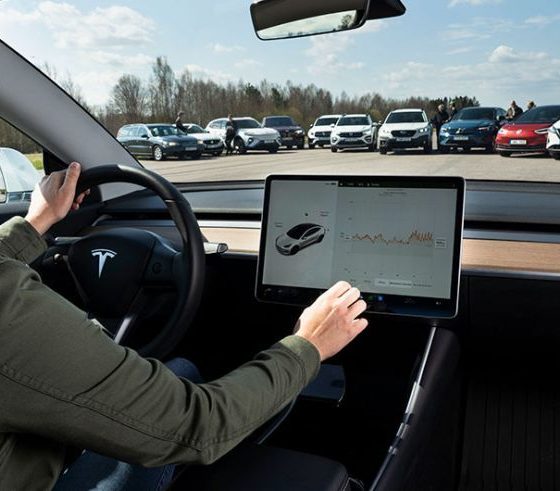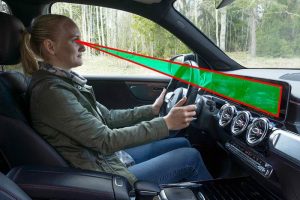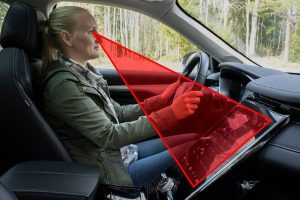Recent testing shows Volvo dominates interior controls in terms of ease of use.
According to Vi Bilägare, Volvo’s interior control layout consistently outperformed many rivals in terms of ease of use. Furthermore, the testing found that physical controls (buttons, knobs, and switches) consistently outperformed touchscreens and haptic options.
The testing conducted by the Swedish car website tested 12 vehicles in their ability to accomplish a variety of tasks while traveling at highway speeds. The four tests included;
- Turn on the seat heater, increase the cabin heating by 2 degrees, and start the defroster.
- Turn on the radio and navigate to “Sweden’s Program 1” station.
- Reset the trip computer.
- Lower the instrument lighting to the lowest setting and turn off the center display.
Vi Bilägare performed the tests continuously and the driver was timed as they completed the tasks; once complete, it was measured how far the vehicle traveled while going 110 kilometers per hour.
The vehicles tested include a 2005 Volvo V70, a Volvo C40, a Volkswagen ID.3, a Tesla Model 3, a Subaru Outback, a Seat Leon, a Nissan Qashqai, an MG Marvel R, a Mercedes GLB, a Hyundai Ioniq 5, a Dacia Sandero, and a BMW iX. And in a surprise to nobody who has driven a mid-2000s Volvo, the old-school V70 dominated the comparison.
In accomplishing all of the tests, the 2005 Volvo only took 10 seconds and traveled 306 meters. The MG Marvel R took the longest time at 44.9 seconds. Every vehicle measured, except the Volvo C40, took over twice the amount of time as the 2005 Volvo, meaning that drivers were paying less attention to the road for a more extended period of time, leading to a less safe experience.
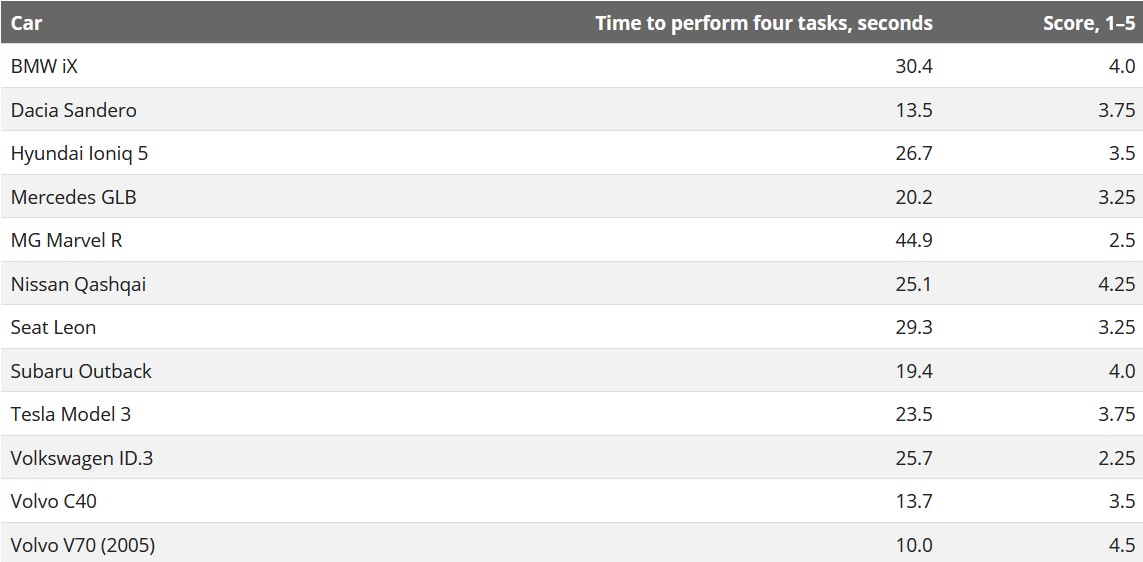
On top of the fact that the touchscreens tested took far longer than the physical controls, some also moved the driver’s attention further away from the road. In the case of the MG Marvel R, the driver had to look down much further than in the other vehicles.
- Credit: Glenn Lindberg/Vi Bilägare
- Credit: Glenn Lindberg/Vi Bilägare
Why are manufacturers so dedicated to touchscreens, haptics, and voice controls? The researchers point out a couple of ideas. Foremost is cost. Manufacturers can make their vehicles more cost-effectively by removing physical controls and centralizing them in a single touchscreen. However, interior design also plays a role, as designers want to create a “clean” driving environment. Finally, some consumers view vehicle buttons as antiquated technology compared to touchscreens and haptic controls, despite their worse performance in accomplishing tasks.
The Tesla Model 3 performed admirably, but it would be interesting to see if the different Tesla models perform differently from one another, particularly if there is a difference between dual screen equipped Model S and the other vehicles. Furthermore, it may be interesting to see how different UI changes could influence this testing. There are likely many ways that touchscreen controls can be improved through software enhancements. Hopefully, automakers can make future changes to continue improving UI and limit how long drivers take their eyes off the road.
What do you think of the article? Do you have any comments, questions, or concerns? Shoot me an email at william@teslarati.com. You can also reach me on Twitter @WilliamWritin. If you have news tips, email us at tips@teslarati.com!

News
Tesla FSD fleet is nearing 7 billion total miles, including 2.5 billion city miles
As can be seen on Tesla’s official FSD webpage, vehicles equipped with the system have now navigated over 6.99 billion miles.

Tesla’s Full Self-Driving (Supervised) fleet is closing in on almost 7 billion total miles driven, as per data posted by the company on its official FSD webpage.
These figures hint at the massive scale of data fueling Tesla’s rapid FSD improvements, which have been quite notable as of late.
FSD mileage milestones
As can be seen on Tesla’s official FSD webpage, vehicles equipped with the system have now navigated over 6.99 billion miles. Tesla owner and avid FSD tester Whole Mars Catalog also shared a screenshot indicating that from the nearly 7 billion miles traveled by the FSD fleet, more than 2.5 billion miles were driven inside cities.
City miles are particularly valuable for complex urban scenarios like unprotected turns, pedestrian interactions, and traffic lights. This is also the difference-maker for FSD, as only complex solutions, such as Waymo’s self-driving taxis, operate similarly on inner-city streets. And even then, incidents such as the San Francisco blackouts have proven challenging for sensor-rich vehicles like Waymos.
Tesla’s data edge
Tesla has a number of advantages in the autonomous vehicle sector, one of which is the size of its fleet and the number of vehicles training FSD on real-world roads. Tesla’s nearly 7 billion FSD miles then allow the company to roll out updates that make its vehicles behave like they are being driven by experienced drivers, even if they are operating on their own.
So notable are Tesla’s improvements to FSD that NVIDIA Director of Robotics Jim Fan, after experiencing FSD v14, noted that the system is the first AI that passes what he described as a “Physical Turing Test.”
“Despite knowing exactly how robot learning works, I still find it magical watching the steering wheel turn by itself. First it feels surreal, next it becomes routine. Then, like the smartphone, taking it away actively hurts. This is how humanity gets rewired and glued to god-like technologies,” Fan wrote in a post on X.
News
Tesla starts showing how FSD will change lives in Europe
Local officials tested the system on narrow country roads and were impressed by FSD’s smooth, human-like driving, with some calling the service a game-changer for everyday life in areas that are far from urban centers.

Tesla has launched Europe’s first public shuttle service using Full Self-Driving (Supervised) in the rural Eifelkreis Bitburg-Prüm region of Germany, demonstrating how the technology can restore independence and mobility for people who struggle with limited transport options.
Local officials tested the system on narrow country roads and were impressed by FSD’s smooth, human-like driving, with some calling the service a game-changer for everyday life in areas that are far from urban centers.
Officials see real impact on rural residents
Arzfeld Mayor Johannes Kuhl and District Administrator Andreas Kruppert personally tested the Tesla shuttle service. This allowed them to see just how well FSD navigated winding lanes and rural roads confidently. Kruppert said, “Autonomous driving sounds like science fiction to many, but we simply see here that it works totally well in rural regions too.” Kuhl, for his part, also noted that FSD “feels like a very experienced driver.”
The pilot complements the area’s “Citizen Bus” program, which provides on-demand rides for elderly residents who can no longer drive themselves. Tesla Europe shared a video of a demonstration of the service, highlighting how FSD gives people their freedom back, even in places where public transport is not as prevalent.
What the Ministry for Economic Affairs and Transport says
Rhineland-Palatinate’s Minister Daniela Schmitt supported the project, praising the collaboration that made this “first of its kind in Europe” possible. As per the ministry, the rural rollout for the service shows FSD’s potential beyond major cities, and it delivers tangible benefits like grocery runs, doctor visits, and social connections for isolated residents.
“Reliable and flexible mobility is especially vital in rural areas. With the launch of a shuttle service using self-driving vehicles (FSD supervised) by Tesla in the Eifelkreis Bitburg-Prüm, an innovative pilot project is now getting underway that complements local community bus services. It is the first project of its kind in Europe.
“The result is a real gain for rural mobility: greater accessibility, more flexibility and tangible benefits for everyday life. A strong signal for innovation, cooperation and future-oriented mobility beyond urban centers,” the ministry wrote in a LinkedIn post.
News
Tesla China quietly posts Robotaxi-related job listing
Tesla China is currently seeking a Low Voltage Electrical Engineer to work on circuit board design for the company’s autonomous vehicles.

Tesla has posted a new job listing in Shanghai explicitly tied to its Robotaxi program, fueling speculation that the company is preparing to launch its dedicated autonomous ride-hailing service in China.
As noted in the listing, Tesla China is currently seeking a Low Voltage Electrical Engineer to work on circuit board design for the company’s autonomous vehicles.
Robotaxi-specific role
The listing, which was shared on social media platform X by industry watcher @tslaming, suggested that Tesla China is looking to fill the role urgently. The job listing itself specifically mentions that the person hired for the role will be working on the Low Voltage Hardware team, which would design the circuit boards that would serve as the nervous system of the Robotaxi.
Key tasks for the role, as indicated in the job listing, include collaboration with PCB layout, firmware, mechanical, program management, and validation teams, among other responsibilities. The role is based in Shanghai.
China Robotaxi launch
China represents a massive potential market for robotaxis, with its dense urban centers and supportive policies in select cities. Tesla has limited permission to roll out FSD in the country, though despite this, its vehicles have been hailed as among the best in the market when it comes to autonomous features. So far, at least, it appears that China supports Tesla’s FSD and Robotaxi rollout.
This was hinted at in November, when Tesla brought the Cybercab to the 8th China International Import Expo (CIIE) in Shanghai, marking the first time that the autonomous two-seater was brought to the Asia-Pacific region. The vehicle, despite not having a release date in China, received a significant amount of interest among the event’s attendees.
